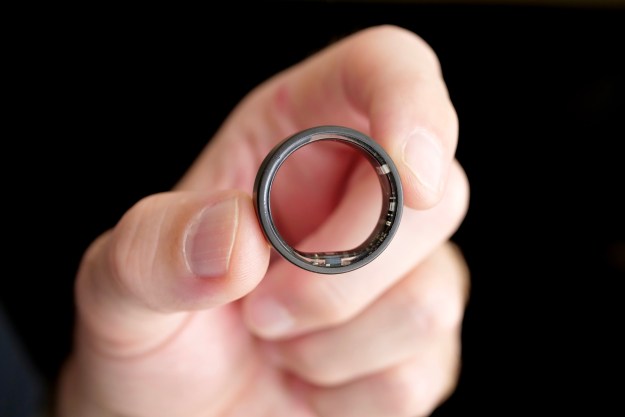
“The Ultrahuman Ring Air tries to take on the Oura Ring with robust health tracking and zero subscription fee. It's not perfect, but it's absolutely worth talking about.”
- No monthly subscription charge
- Comprehensive sensor array
- Four-day battery life
- 22 workout tracking modes
- Unobtrusive and comfortable design
- Confusing app lacks clear motivation
- No way to change your goals
- App is cluttered and lacks focus
To wear any fitness tracker all the time, it has to be comfortable, convenient, and useful. I’ve been wearing the Ultrahuman Ring Air smart ring for a month and can confidently say it ticks the first two boxes. The third box is far more complicated, and that’s going to be the focus of my review.
- Ultrahuman Ring Air: design
- Ultrahuman Ring Air: sensors, durability, and battery
- Ultrahuman Ring Air: health and sleep tracking
- Ultrahuman Ring Air: mobile app
- Ultrahuman Ring Air: fitness tracking and encouragement
- Ultrahuman Ring Air: price, availability, and subscriptions
- Ultrahuman Ring Air: is it helpful?
- Ultrahuman Ring Air: verdict
Let’s see if this ring is worth putting on your finger — permanently.
Ultrahuman Ring Air: design
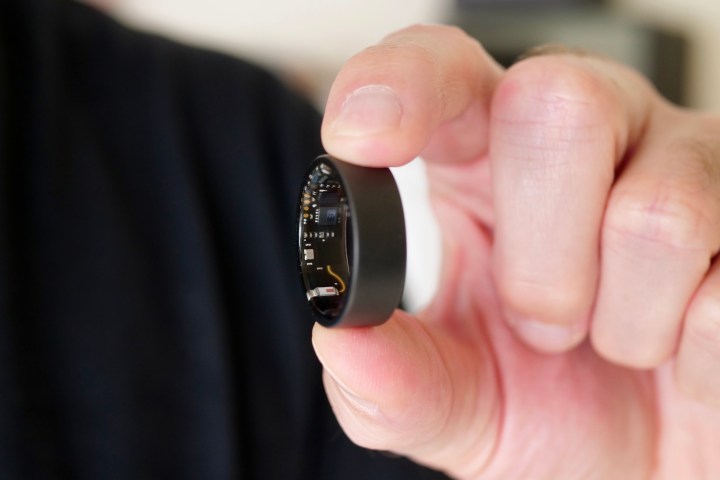
The Ultrahuman Ring Air is a very modern ring, by which I mean it doesn’t have any design flourishes and has a strictly by-the-numbers shape. There’s no taper at the edges, no ridges or dimples, and currently no alternative colors either. It’s a circular, plain ring, which, combined with the dark matte gray color (a polished version is coming soon), means it’s most likely to appeal to men. This simplicity can work in its favor as it doesn’t look flashy, but it doesn’t have much appeal if you do want to make a statement.
An advantage of wearing a smart ring is it leaves wrists free to wear a watch if you want, something you can’t really do with a smartwatch, and this appeals a lot to me personally. It’s also far less sporty and techy than a fitness band. From a convenience point of view, a smart ring makes a great deal of sense. It doesn’t look like a piece of technology either, as all the sensors are hidden on the underside, so when it’s on your finger, you can’t see them at all.
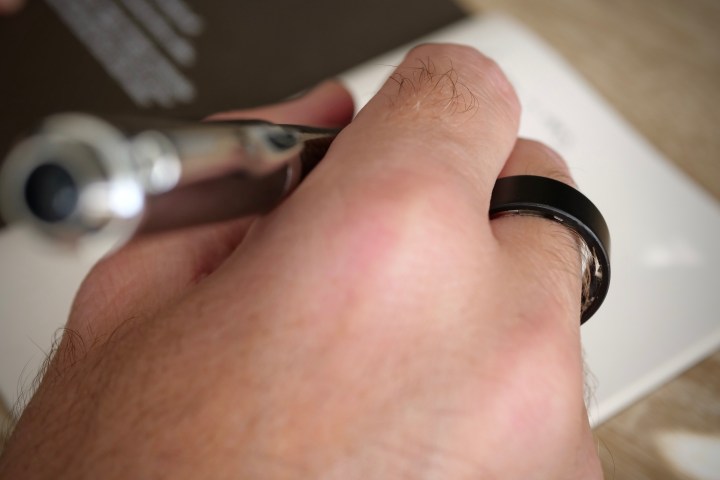
The Ultrahuman Ring Air is made of titanium with a resin underside. I’ve worn it all day, every day, and it hasn’t irritated my skin at all. It has started to show a few small scratches around the edges, but nothing that detracts from the look at the moment. The matte finish does look like it’ll mark quite easily if you drag it against brick or metal, and because the ring is quite substantial, I’ve felt an uncomfortable scraping sensation across surfaces like these already.
I’ve worn it on the same finger where I have worn an Oura Ring for the last 18 months, so I’m very used to something being on it. I have “felt” the Air more though, especially for the first few days. It’s almost imperceptibly different in terms of numbers, but I felt a difference when wearing the Ultrahuman Ring Air after the Oura. It’s 8.1mm wide compared to the Oura’s 7.9mm and around the same thickness, but it hasn’t been uncomfortable.
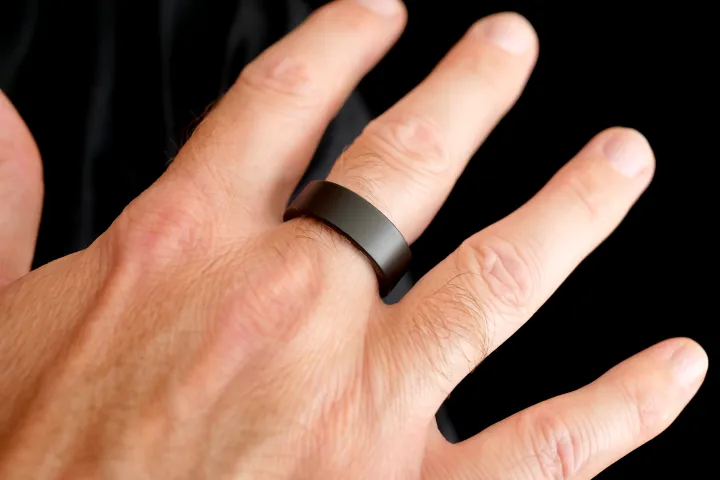
Before getting the Air, I used the sizing kit and at first selected a size 11. However, when I received the ring, it was too big — something I put down to trying the sizing kit on some very hot days. Ultrahuman swapped it for a size 10, which fits perfectly. Interestingly, my Oura Ring is a size 11, so the two may not use the same sizing structure. Both the size 10 Ultrahuman Ring Air and the size 11 Oura Ring weigh 3 grams on my scales.
I find the Ultrahuman Ring Air’s design a bit too ordinary, and the flat sides give it a rather generic appearance that lacks creativity. It reminds me of smartwatches designed by engineers without truly understanding what draws people to traditional watches. The end result is a facsimile of a watch without any of the flair required for an emotional connection.

This matters. The Ultrahuman Ring Air is smart jewelry and is supposed to be worn all the time, and for that to happen, it has to make you feel good in some way. For me, the Ultrahuman Ring Air is functional, but not especially desirable. It’s a very different proposition than the Oura Ring, which I’m always proud of. I appreciate Oura’s varied designs and finishes, as well as the way it has been carefully shaped.
This doesn’t stop the Ultrahuman Ring Air from being comfortable or from it working, and not everyone will be as worried as I am about the way a piece of wearable tech looks.
Ultrahuman Ring Air: sensors, durability, and battery
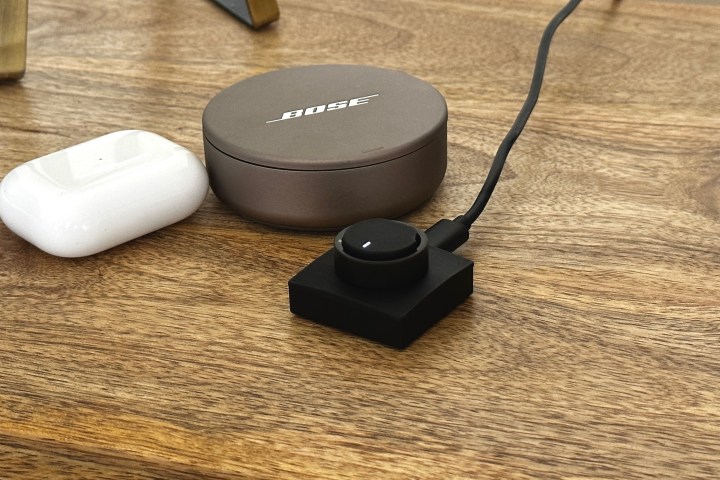
Under the hypoallergenic resin underside of the ring is the sensor array. It uses an Infrared Photoplethysmography (PPG) sensor with red, green, and infrared LEDs to monitor your heart rate and blood oxygen. Plus, there is a skin temperature sensor and a six-axis accelerometer for movement tracking. Unlike the Oura Ring’s nubbins to ensure a good connection with the skin, it has a flat section that’s designed to sit under your finger.
It also hides the 24mAh battery, which is recharged by placing the ring on an included plinth. I’ve found the battery lasts for around four days, sometimes less if you use it to track workouts. It takes up to two hours to fully recharge. However, it’s more convenient to pop the ring on the plinth when you shower or get ready in the morning, so you keep the battery topped up. This avoids having to fully recharge it on a regular basis.

The battery life is shorter than on the Oura Ring, and I have found myself fully recharging the Ring Air on a more regular basis due to it, as I don’t always remember to top it up when I’m in the shower. The Oura Ring’s extra day or two of use compensates for my poor memory, but this may not be an issue for you. Regardless, the four days I get from the Ultrahuman Ring Air is still impressive for such a tiny device. One thing to note is the LED on the charging plinth stays illuminated all the time, whether the ring is on charge or not, which means if you keep it next to your bed, it needs to be unplugged if you’re sensitive to light at night.
The titanium case and its tungsten carbide coating should keep it free from too many scratches, but the company warns against wearing the ring when holding other metal objects, so you may not want to wear it when weight training if you want to truly protect the finish. It’s water resistant to 100 meters, so it’s fine for swimming, showering, and wearing when you wash your hands.
Ultrahuman Ring Air: health and sleep tracking
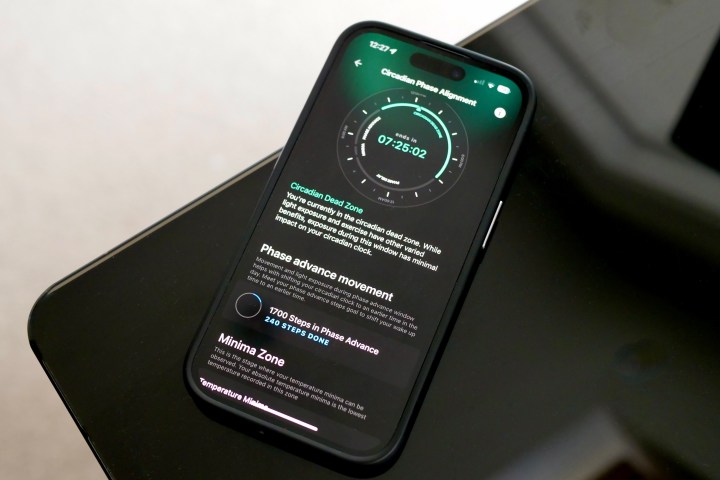
The Ultrahuman Ring Air requires more work and effort on your part than the Oura Ring, including inputting how you feel during the day and your daily food intake. You also have to take time to understand what the Ultrahuman Ring Air’s app is talking about and the language it uses. The Ultrahuman Ring Air isn’t a wear-and-forget lifestyle tracker (it’s definitely a step beyond that), and to get the most from it, you’ll have to put in effort on all fronts.
That’s fine, but it’s unfortunate Ultrahuman uses what I’d call unique language to get its point across, as none of it feels familiar even to someone who has used dozens of health and fitness products.
Here’s what I mean. Its primary system to help you manage your day is called the Phase Response Curve (PRC), and it helps you understand when is a good time to exercise, drink coffee, sleep, or even avoid light. In it, there’s a Circadian Dead Zone, a Minima time, and Phase Advance and Phase Delay periods to pay attention to during the day.

The trouble is it doesn’t effectively explain what all these are or why I should be taking note of them. The app is obsessed with two things: exposure to light and “stimulants,” all seemingly with the goal of shifting my wake-up time to one that’s earlier. At least, I think it is. I’m never entirely sure why it wants me to do half the things it suggests because the language used in the app is dense and confusing. If I need an explanation for the explanation, it means something is wrong, and that’s how I feel about a lot of the Ultrahuman Ring Air’s system.
The stimulant obsession is odd. During my Circadian Dead Zone — which normal people call “daytime” — the app highlights when it’s my “Stimulant Permissible Window,” which is about suggesting when is a good time to have coffee and how long the caffeine will stay in my system. As time passes in this window, it provides suggestions of what caffeinated drinks are still suitable. It puts a great deal of emphasis on this, which in a way is a good thing as it’s something not everyone considers each day, but I do think it could be presented in a friendlier manner.
The app is obsessed with two things: my exposure to light and stimulants.
Outside of this, it presents three basic numbers rating your movement, sleep, and recovery. There’s plenty of additional detail for each of them, such as steps and workouts for movement, plus resting heart rate, skin temperature, and heart rate variability (HRV) for recovery. Each number gives you an idea of how well-prepared you are for the day and whether you should push to exercise or take a break. Heart rate, skin temperature, and HRV all get their own breakout sections too, so you can always see the individual readings if you want.
Wearing the Ultrahuman Ring Air overnight is essential, as it uses sleep to inform a lot of its suggestions. It shows the time you spend asleep, then breaks it down into different stages, and records heart rate, HRV, blood oxygen, skin temperature, and movement. Each metric then gets a rating and is compared to previous sleep scores and performance too. Like so much of the Ultrahuman Ring Air app, it’s filled with dense data and graphs, plus snippets of general advice on how to improve, like taking a shower before bed.
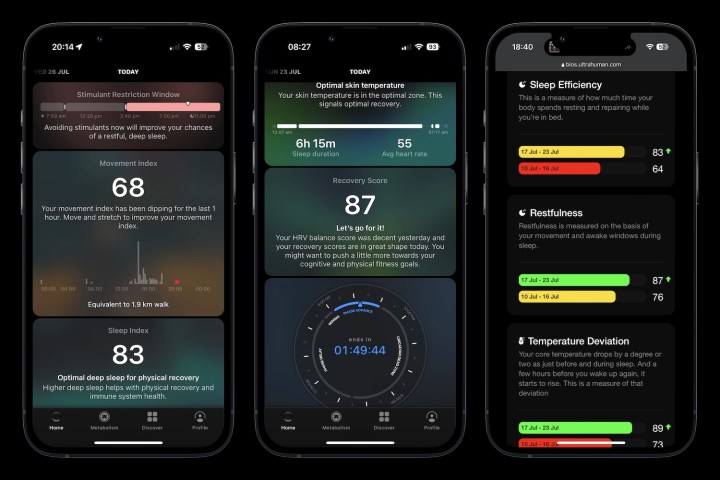
There’s a lot of data available, but it’s not presented in a very friendly way, and I’ve not felt especially comfortable with the app, its suggestions, or trying to get a handle on how I’m performing.
The language is a big part of this, as is the design of the app, which I’ll come to soon. I find the scores informative enough to gauge how I’m doing, plus the data is in line with what I expect from my body, but everything around them feels complicated without offering clear advice on why I should pay attention to it.
Ultrahuman Ring Air: mobile app

Because there is no display on the Ultrahuman Ring Air, everything you do with the ring is performed through the app, and this makes it perhaps even more important than the hardware itself. On the positive side, it has been reliable (I have used it on an iPhone 14 Pro, and there is an Android app available, too). And although it often needs to be opened to sync with the ring itself, I haven’t had any connection problems.
I’ve already talked about functionality, but I want to talk about design before going into it a little more. The main page shows all your data, and this is the default view when you open the app, but along the bottom of the screen are further options. The first, labeled Metabolism, is a big advertisement for Ultrahuman’s M1 glucose monitor, and the second is Discover, which contains Ultrahuman’s podcasts, mindfulness sessions, and other audio/visual content. The final section is your own profile.
It’s a very different experience than the Oura Ring.
The Metabolism advertisement isn’t my favorite use of space, and the profile section is a bit of a waste too; the app’s overall look could have been simplified if these were relegated to a secondary menu somewhere. The Ultrahuman app and experience are already quite busy, data-dense, and somewhat confusing. Focusing on making the screens more logical would help capture attention, which the app isn’t very good at currently.
It’s a very different experience than the Oura Ring, which always makes all the relevant scores very clear, and has a different screen for each one. The Ultrahuman Ring Air isn’t as “friendly” or accessible in general and clearly targets a very different kind of person. However, it doesn’t always succeed in its ambitions, as it gets bogged down in trying to be different.
Ultrahuman Ring Air: fitness tracking and encouragement

The app’s Timeline view collates all your activity and the recommendations it makes around your phases, and hidden by the side is a + symbol. Here, you can add in your food and water intake, imput your weight, and record a workout too. Listed as a beta feature at the time of writing, the ring tracks 22 different activities — including walking, running, strength training, football, cricket, and more.
I’ve tracked several workouts with both the Ultrahuman Ring Air and the Samsung Galaxy Watch 6 Classic, and both broadly agree on heart rate, although they differ a little more in calorie burn, but not to the point where either seems entirely unrealistic. The ability to track simple workouts is very helpful and a feature still missing from the Oura Ring, which concentrates on walking, cycling, and running.
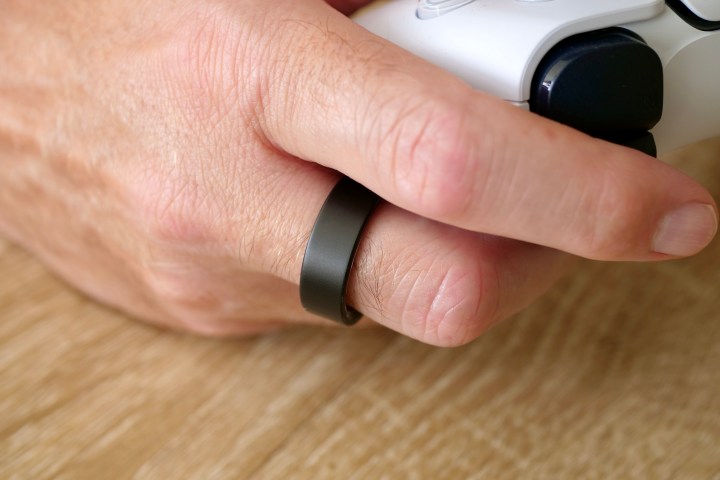
It makes the Ultrahuman Ring Air a realistic alternative to a fitness band or a smartwatch if you aren’t worried about notifications and apps, as it can be used to fully monitor your daily activities. It seems to do so accurately, too, something I’ve seen across the entire system, with the sleep tracking essentially matching the Galaxy Watch 6 Classic’s results.
The app sends quite a lot of notifications during the day, letting you know about things like your phase, stimulant window, and progress toward your goal. Annoyingly, the goals are set by the app with no way to modify them. The targets it sets for me are entirely unrealistic (11,000 steps a day and 16 hours of activity), so I never meet them, and even if I was to really push, I’d probably still find it quite hard. The decision not to let me set my own goals isn’t motivational. In fact, it’s quite the opposite.
Ultrahuman Ring Air: price, availability, and subscriptions

The Ultrahuman Ring Air does not require a subscription to use. This is the big differentiator between it and the Oura Ring. If you buy the Oura, there’s a $6-per-month charge to access all the data it collects, and the experience is very basic if you don’t pay. This means you pay the one-off charge of $349 for the Ultrahuman Ring Air ring, and that’s all.
At this price, it’s comparable to the Oura Ring on its own and not that different from the Apple Watch Series 8 and the Samsung Galaxy Watch 6 Classic, but it is more expensive than the Apple Watch SE 2 and the Garmin Vivomove Trend — all of which should be considered before buying a smart ring.
The lack of a subscription fee is a big deal.
The ring is available now, but the website warns there is a substantial four-to-six week wait after ordering, and you should probably factor in another week or so if you use the sizing kit. I’d absolutely recommend doing so, and not just assume the Air is going to be the same size as other rings you own (and do be aware of weather conditions and what effect it has on your fingers when trying it too).
The lack of a subscription fee is a big deal. No, I don’t think the app is as well designed or accessible as the Oura Ring’s, but it’s clearly going in a different direction, so differences are to be expected. However, Oura isn’t very forthcoming with updates and new features to justify the ongoing charge, and the Ultrahuman Ring Air has had more software updates in the month I’ve worn it than the Oura has had most of this year.
Ultrahuman Ring Air: is it helpful?
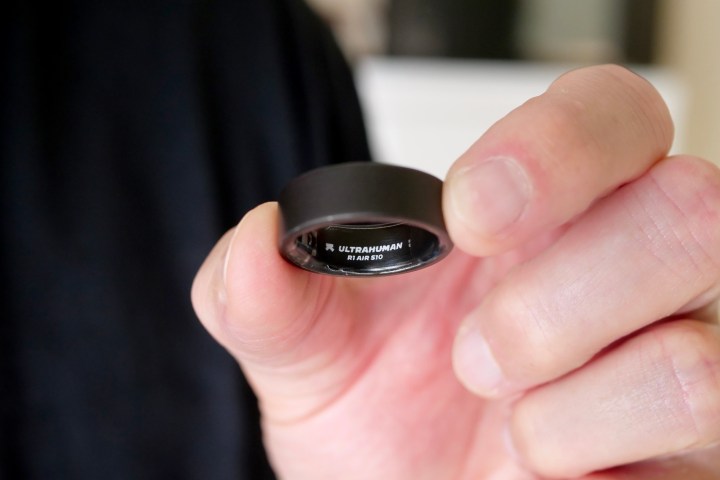
The Ultrahuman Ring Air is comfortable and convenient, but is it useful? It’s an odd device. It’s not really a full-fledged, fashion-forward health and fitness tracker like a Garmin Vivomove Trend smartwatch or an Apple Watch, but it tries to be something like them, certainly more so than the Oura Ring. Its usefulness can be measured by how often I feel like it has helped me understand my condition, modify my behavior, or even just open the app to see how things are progressing.
It’s somewhat successful. I do regularly look to see how it rated my sleep, what my HRV and skin temperature were overnight, and how my recovery looks. I’ve not used the movement metric as I know I’m not going to get close to its target, and while the focus on stimulants is interesting, it’s not something I’d buy a health-monitoring device to understand.

The inability to set your own goals is frustrating for me, as I can’t push myself at my own pace. Instead, the goals are meaningless, as I know I will almost never reach them. It provides plenty of data on your sleep, and while it goes on about adjusting your circadian clock, it doesn’t really tell you why you should do so — or the benefits it may bring.
The app is chock-full of data and graphs, but it also has ads for the company’s other products, which even infiltrate the Discover section. These include podcasts and sections pushing metabolic fitness and, therefore, Ultrahuman’s M1 glucose monitor. Elsewhere in Discover, some of the additional mindfulness content is unusual, to say the least. The Bedtime Stories section is particularly different, with some autonomous sensory meridian response (ASMR)-style romantic stories and stories narrated from a cat’s point of view. As with all these things, some people may find them very relaxing or helpful, but I tend to find them distracting and hard to take seriously.
Ultrahuman Ring Air: verdict

This complexity, lack of customization, and confusion over what you’re supposed to be working toward and why — along with added content of little value — means the Ultrahuman Ring Air falls behind many of its rivals when it comes to effectively and simply monitoring your health and fitness on a daily basis. For example, the joy of the Apple Watch is how it removes a lot of the bother associated with tracking health, yet is still powerful and lets you set it up to your liking; using and understanding all the tools is also effortless. The Apple Fitness app may not be very user-friendly, but I find it more accessible at a glance than the Ultrahuman app.
The Ultrahuman Ring Air feels more daring and scrappy than the Oura Ring, which has a polish and maturity the Air lacks. It’s more fitness-oriented than the Oura, which definitely skews more toward lifestyle and health. For example, the Ultrahuman platform connects with the Apple Health, Google Fit, Garmin, Fitbit, MyFitnessPal, Polar, and Suunto apps. Oddly, it doesn’t link with Strava, though. Choosing between them will come down to how important monitoring and improving your fitness is, as the Ultrahuman Ring Air is far more suited to this than the Oura Ring.
The Ultrahuman Ring Air is worth buying and wearing, but do understand it is also trying very hard to be different and isn’t always successful. This makes it more confusing and less user-friendly than it needs to be, and that’s a shame, as the hardware is great, and there is plenty of potential in its ability. Not charging a subscription fee is a big bonus for a fitness wearable these days too.
The Ultrahuman Ring Air isn’t the Oura Ring killer it could have been, but if you’re in the market for a smart ring and want something that does things differently — and won’t keep charging you every month — it’s certainly worth a look.




